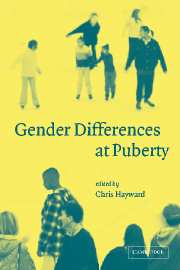Book contents
- Frontmatter
- Contents
- List of figures
- List of tables
- List of contributors
- Preface
- Acknowledgments
- 1 Methodological concerns in puberty-related research
- Part 1 Sex differences in hormones and their effect at puberty
- Part 2 Girls at puberty
- Part 3 Boys at puberty
- 7 Boys at puberty: psychosocial implications
- Part 4 Puberty and psychopathology
- Part 5 Pubertal timing: antecedents
- Part 6 Pubertal timing: consequences
- Part 7 Puberty and context
- Index
- References
7 - Boys at puberty: psychosocial implications
Published online by Cambridge University Press: 22 September 2009
- Frontmatter
- Contents
- List of figures
- List of tables
- List of contributors
- Preface
- Acknowledgments
- 1 Methodological concerns in puberty-related research
- Part 1 Sex differences in hormones and their effect at puberty
- Part 2 Girls at puberty
- Part 3 Boys at puberty
- 7 Boys at puberty: psychosocial implications
- Part 4 Puberty and psychopathology
- Part 5 Pubertal timing: antecedents
- Part 6 Pubertal timing: consequences
- Part 7 Puberty and context
- Index
- References
Summary
I am pretty confused. I wonder whether I am weird or normal. My body is starting to change. I get nervous in the locker room during PE class.
Mike, age 11I am fourteen already. But I still look like a kid. I got teased a lot, especially by other guys. I am always the last one picked for sides in basketball because I am so short. Girls don't seem to be interested in me either because most of them are taller than I am.
Robert, age 14Although pubertal development in boys has fascinated people for centuries, scientific inquiry into this area did not begin until the middle of the twentieth century. Approximately a dozen well-researched articles have appeared in the past decade that provide excellent overviews on the study of psychosocial implications of pubertal changes (e.g., Alsaker, 1995, 1996; Brooks-Gunn, Graber, and Paikoff, 1994; Brooks-Gunn, Petersen, and Compas, 1995; Brooks-Gunn and Reiter, 1990; Buchanan, Eccles, and Becker, 1992; Connolly, Paikoff, and Buchanan, 1996; Graber, Petersen, and Brooks-Gunn, 1996; Paikoff and Brooks-Gunn, 1991; Susman, 1997; Susman and Petersen, 1992). This chapter will focus on studies of the psychosocial implications of pubertal changes in boys; it will not be an exhaustive review, but, rather, will serve to highlight some of the important areas of research related to pubertal changes among boys. This chapter is structured in five sections. First, the physical and physiological changes that boys experience during puberty will be discussed.
- Type
- Chapter
- Information
- Gender Differences at Puberty , pp. 113 - 134Publisher: Cambridge University PressPrint publication year: 2003
References
- 23
- Cited by

